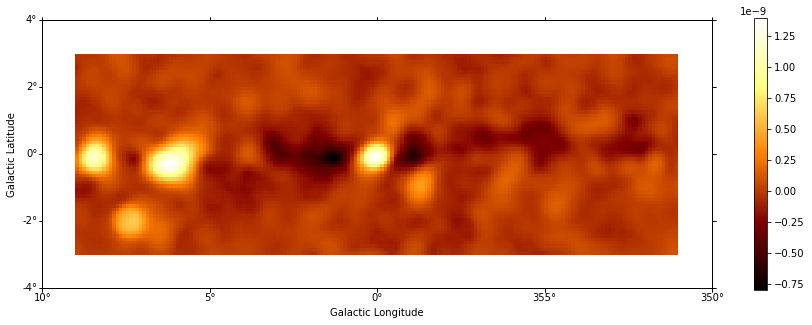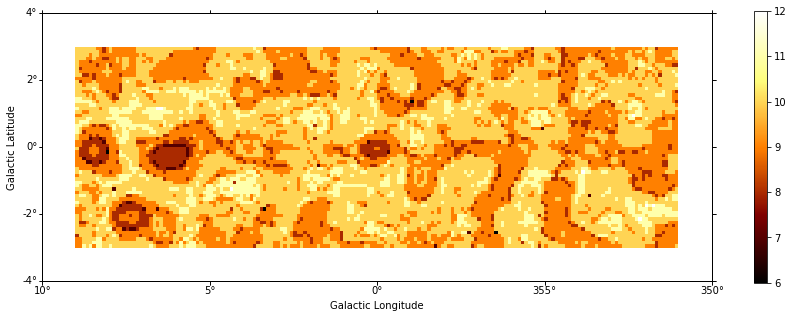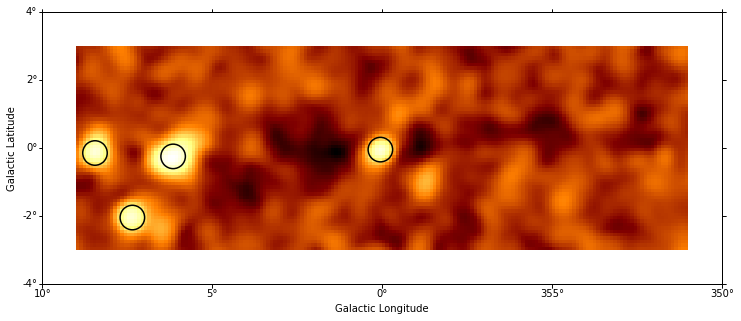This is a fixed-text formatted version of a Jupyter notebook.
- Try online
- You can contribute with your own notebooks in this GitHub repository.
- Source files: detect_ts.ipynb | detect_ts.py
Source detection with Gammapy¶
Introduction¶
This notebook show how to do source detection with Gammapy using one of the methods available in gammapy.detect.
We will do this:
- produce 2-dimensional test-statistics (TS) images using Fermi-LAT 2FHL high-energy Galactic plane survey dataset
- run a peak finder to make a source catalog
- do some simple measurements on each source
- compare to the 2FHL catalog
Note that what we do here is a quick-look analysis, the production of real source catalogs use more elaborate procedures.
We will work with the following functions and classes:
Setup¶
As always, let’s get started with some setup …
In [1]:
%matplotlib inline
import matplotlib.pyplot as plt
In [2]:
import numpy as np
from astropy import units as u
from astropy.convolution import Gaussian2DKernel
from astropy.coordinates import SkyCoord
from gammapy.maps import Map
from gammapy.detect import TSMapEstimator, find_peaks
from gammapy.catalog import source_catalogs
Compute TS image¶
In [3]:
# Load data from files
filename = "$GAMMAPY_DATA/fermi_survey/all.fits.gz"
opts = {
"position": SkyCoord(0, 0, unit="deg", frame="galactic"),
"width": (20, 8),
}
maps = {
"counts": Map.read(filename, hdu="COUNTS").cutout(**opts),
"background": Map.read(filename, hdu="BACKGROUND").cutout(**opts),
"exposure": Map.read(filename, hdu="EXPOSURE").cutout(**opts),
}
In [4]:
%%time
# Compute a source kernel (source template) in oversample mode,
# PSF is not taken into account
kernel = Gaussian2DKernel(2.5, mode="oversample")
estimator = TSMapEstimator()
images = estimator.run(maps, kernel)
CPU times: user 534 ms, sys: 57.7 ms, total: 591 ms
Wall time: 1.86 s
Plot images¶
In [5]:
plt.figure(figsize=(15, 5))
images["sqrt_ts"].plot();

In [6]:
plt.figure(figsize=(15, 5))
images["flux"].plot(add_cbar=True);

In [7]:
plt.figure(figsize=(15, 5))
images["niter"].plot(add_cbar=True);

Source catalog¶
Let’s run a peak finder on the sqrt_ts image to get a list of
sources (positions and peak sqrt_ts values).
In [8]:
sources = find_peaks(images["sqrt_ts"], threshold=8)
sources
Out[8]:
Table length=4
| value | x | y | ra | dec |
|---|---|---|---|---|
| deg | deg | |||
| float64 | int64 | int64 | float64 | float64 |
| 11.386 | 38 | 37 | 270.13528 | -23.76653 |
| 10.044 | 15 | 38 | 271.27051 | -21.71617 |
| 10.008 | 99 | 39 | 266.48351 | -28.91953 |
| 9.7378 | 26 | 19 | 272.49049 | -23.60089 |
In [9]:
# Plot sources on top of significance sky image
plt.figure(figsize=(15, 5))
images["sqrt_ts"].plot()
plt.gca().scatter(
sources["ra"],
sources["dec"],
transform=plt.gca().get_transform("icrs"),
color="none",
edgecolor="black",
marker="o",
s=600,
lw=1.5,
);

Measurements¶
- TODO: show cutout for a few sources and some aperture photometry measurements (e.g. energy distribution, significance, flux)
In [10]:
# TODO
Compare to 2FHL¶
TODO
In [11]:
fermi_2fhl = source_catalogs["2fhl"]
fermi_2fhl.table[:5][["Source_Name", "GLON", "GLAT"]]
Out[11]:
Table length=5
| Source_Name | GLON | GLAT |
|---|---|---|
| deg | deg | |
| bytes18 | float32 | float32 |
| 2FHL J0008.1+4709 | 115.339355 | -15.068757 |
| 2FHL J0009.3+5031 | 116.12411 | -11.793202 |
| 2FHL J0018.5+2947 | 114.46349 | -32.54235 |
| 2FHL J0022.0+0006 | 107.171715 | -61.86175 |
| 2FHL J0033.6-1921 | 94.28002 | -81.22237 |
What next?¶
In this notebook, we have seen how to work with images and compute TS images from counts data, if a background estimate is already available.
Here’s some suggestions what to do next:
- TODO: point to background estimation examples
- TODO: point to other docs …